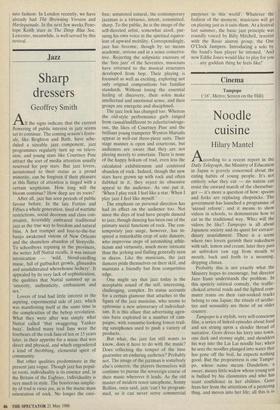Jazz
Sharp dressers
Geoffrey Smith
All the signs indicate that the current flowering of public interest in jazz seems set to continue. The coming season's festiv- als, like Brighton and Bath, have sche- duled a sizeable jazz component, jazz programmes regularly turn up on televi- sion, and young stars like Courtney Pine attract the sort of media attention usually reserved for pop stars. But jazz lovers, accustomed to their status as a proud minority, can be forgiven if their pleasure at this flutter of attention is tinged with a certain scepticism. How long will the bloom continue? How deep are its roots?
After all, jazz has seen periods of public favour before. In the late Forties and Fifties a whole generation, tired of wartime restrictions, social decorum and class con- straints, feverishly embraced traditional jazz as the true way to freedom and natural bliss. A hot trumpet and four-to-the-bar banjo awakened visions of New Orleans and the shameless abandon of Storyville. To schoolboys repining in the provinces, the writer Jeff Nuttal recalls, it was instant intoxication — 'wild, blood-curdling music, full of gutbucket growls, glissandos and unadulterated whorehouse lechery'. It appealed by its very lack of sophistication, the qualities that Nuttal summed up as 'sincerity, authenticity, enthusiasm and sex.'
Lovers of trad had little interest in the aspiring, experimental side of jazz, which was manifesting itself at the same time in the complexities of the bebop revolution. What they were after was simply what Nuttal called 'that swaggering Yankee buzz'. Indeed many trad fans were the forebears of the rock fans of ten or 15 years later, in their appetite for a music that was direct and physical, and which engendered a kind of throbbing, elemental spirit of community.
But other qualities predominate in the present jazz vogue. Though jazz has popul- ist roots, individuality is its essence and, in the Britain of the Eighties, individuality is very much in style. The boisterous simplic- ity of trad is vieux jeu, as is the manic mass orientation of rock. No longer the care-
free, untutored natural, the contemporary jazzman is a virtuoso, intent, committed, sharp. To the public, he is the image of the self-directed artist, somewhat aloof, pur- suing his own voice in the spiritual equiva- lent of upward mobility. Correspondingly, jazz has become, though by no means academic, serious and in a sense conserva- tive. Rejecting the solipsistic excesses of the 'free jazz' of the Seventies, musicians have returned to the musical structures developed from bop. Their playing is focussed as well as exciting, exploring not only original compositions but familiar standards. Without losing the essential feeling of discovery, their solos make intellectual and emotional sense, and their groups are energetic and disciplined.
The jazz look has changed too. Whereas the old-style performance garb ranged from casual/indifferent to eclectic/outrage- ous, the likes of Courtney Pine and the brilliant young trumpeter Wynton Marsalis appear in well-cut three-piece suits. Their stage manner is open and courteous, but audiences are aware that they are not playing merely to entertain. There is none of the happy hokum of trad, even less the calculated exhibitionism and contrived abandon of rock. Indeed, though the new stars have grown up with rock and often dabbled in it, they reject its obsessive appeal to the audience. As one put it, 'When I play rock I feel like a star. When I play jazz I feel like myself.'
The emphasis on personal direction has had its effect on the audience too. Not since the days of trad have people danced to jazz, though dancing has been one of the primary social functions of rock. The con- temporary jazz surge, however, has in- spired a remarkable crop of solo dancers, who improvise steps of astonishing athle- ticism and virtuosity, much more intricate than the jerking and flailing generally seen in discos. Like the musicians, the jazz dancers pride themselves on their skill, and maintain a friendly but firm competitive edge.
One might say that jazz today is the acceptable sound of the self, interesting, challenging, complex. Its status accounts for a certain glamour that attaches to the figure of the jazz musician, who seems to epitomise a new aristocracy of individual- ism. It is this allure that advertising agen- cies have exploited in a number of cam- paigns, with romantic-looking loners trail- ing saxophones used to push a variety of products.
But what, the jazz fan still wants to know, does it have to do with the music? Does reflecting the temper of the time guarantee an enduring audience? Probably not. The image of the jazzman is somebody else's concern; the players themselves will continue to pursue the sovereign course of their music wherever it leads. As the old master of modern tenor saxophone, Sonny Rollins, once said, jazz 'can't be program- med, so it can never serve commercial purposes ' in this world'. Whatever the fashion of the moment, musicians will go on playing just as it suits them. At a festival last summer, the basic jazz principle was roundly voiced by Billy Mitchell, tenorist with the Basie alumni group, the One O'Clock Jumpers. Introducing a solo by the band's bass player he intoned, 'And now Eddie Jones would like to play for you . . . any goddam thing he feels like!'






























































 Previous page
Previous page